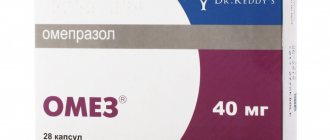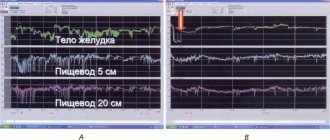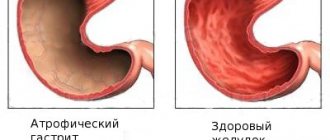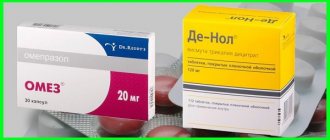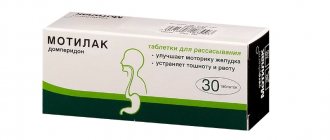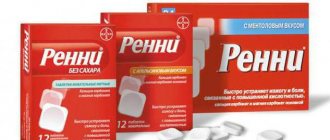To reduce the production of hydrochloric acid by the stomach glands, the drug omez is used. With its use, it is possible to achieve a rapid positive effect in the treatment of gastritis, gastric or duodenal ulcers, as well as many other pathologies.
Omez and omeprazole are identical medications with the same active ingredient. They have the same indications and, if contraindications are violated, cause similar adverse reactions in the body. The main difference between the drugs is different auxiliary ingredients.
The active ingredient in the drug Omez is omeprazole. The drug is produced in two forms: capsules and powder. When they say “omez tablets,” they mean transparent capsules filled with white granules. The coating may be coated with hypromellose, enteric coating, or gelatin.
A medicinal solution for internal consumption is prepared using Omez Insta powder. An additional ingredient in it is anhydrous sodium carbonate. A solution for infusion is prepared from lyophilized powder in bottles.
Omez - description
The medicine Omez is produced in India. As a proton pump inhibitor, omeprazole contained in the drug inhibits the activity of special enzymes that are secreted by the parietal cells of the stomach. This causes a decrease in the production of hydrochloric acid, which is present in increased quantities in patients with gastritis and a number of other diseases.
Omeprazole is activated precisely in the acidic environment of the stomach, affecting the secretory tubules.
Thanks to the highly effective action of Omez, the level of basal and stimulated acid secretion decreases, and in the latter case, the work of the product does not depend on the cause of the irritating factor.
The drug is available in dosages of 10, 20 and 40 mg, while when taking 20 mg, the effect develops within an hour. Up to 50% of the substance continues to act throughout the day, but maximum effectiveness is achieved with a course of administration after 4 days. 3 days after the end of therapy, the secretion of hydrochloric acid is restored.
Mechanism of action
Both omeprazole and pantoprazole are benzimidazole derivatives, which results in similar physicochemical properties and pharmacological actions. Both drugs are prodrugs: they form the active form in the secretory tubules of parietal cells. It is into the lumen of the latter that parts of the molecules of the enzyme responsible for the main stage of the production of hydrochloric acid—H+/K+-ATPase—protrude.
Activation of omeprazole and pantoprazole occurs with the sequential addition of a hydrogen atom to the pyridine and benzimidazole rings. The main condition for activation is a strongly acidic environment, corresponding to that in the secretory tubules of parietal cells.
After ionization, omeprazole and pantoprazole can no longer penetrate the cell membrane and accumulate inside the tubules. The concentration of drugs in the lumen of the secretory tubules is 1000 times higher than the concentration in the blood and in the parietal cell. It is noteworthy that pantoprazole concentrates in the tubular lumen more slowly than omeprazole: the time required for 50% blockade of H+/K+ ATPase by omeprazole and pantoprazole is 400 and 1100 seconds, respectively. Thus, omeprazole is activated faster than pantoprazole and binds to the proton pump in a shorter time [2, 3].
The results of an in vitro study showed that omeprazole achieved maximum proton pump inhibition after 20 minutes of administration, and pantoprazole after 30 minutes.
Omeprazole - what kind of drug?
Like Omez, Omeprazole is available in the form of capsules, which contain 20 or 40 ml of the main substance - omeprazole. The medicine under this trade name is represented by most large pharmaceutical companies, Teva, Sintez, Kanonpharma and others.
Manufacturers indicate that the maximum effect in the body is created 2 hours after the start of administration, although it begins after an hour.
Due to the presence of a similar active substance, the effect of Omeprazole is the same. In patients with ulcers, gastritis, and erosions, it helps maintain the pH level by 3.0 for up to seventeen hours. The drug is processed by the liver, so if the organ’s function is insufficient, it should be taken with caution.
Like Omez, this remedy may have side effects:
- discomfort in the stomach;
- diarrhea, constipation;
- flatulence;
- nausea, vomiting;
- changes in blood composition (rare);
- increased AST, ALT of the liver;
- taste disturbances.
In patients with liver pathologies, Omeprazole sometimes caused toxic hepatitis - inflammation of the liver tissue, which was transient in nature. Allergic reactions are rare, they mainly concern skin forms - itching, rash, redness, erythema. Bronchospasm, Quincke's edema and other systemic forms are much less common. Also, medications based on this substance can manifest themselves as hyperhidrosis, swelling of the legs, and the growth of cysts in the stomach during long-term therapy (cysts resolve on their own).
WE RECOMMEND THE ARTICLE!
Kvamatel is used in the treatment of stomach ulcers, pancreatitis and gastroduodenitis. Read more >>
Adverse reactions
Both PPIs, omeprazole and pantoprazole, have a number of identical side effects. Thus, when taking them, dizziness, headache, urticaria, abdominal pain, constipation or diarrhea, flatulence, and other dyspeptic symptoms, in particular nausea and vomiting, may develop. Rare adverse events associated with both drugs include hip fracture and rhabdomyolysis [4].
Along with general side effects, omeprazole and pantoprazole also exhibit individual side effects. Thus, with the use of omeprazole, damage to the liver, kidneys, pancreatitis, and fever may develop. In patients receiving pantoprazole, life-threatening complications were recorded - Stevens-Johnson syndrome (severe hypersensitivity reaction with damage to the skin and mucous membranes), Lyell's syndrome (a very severe form of allergic bullous dermatitis), as well as changes in the blood picture - thrombocytopenia. With a probability of more than 1%, when using pantoprazole, acute gastroenteritis, pain in the joints, back, as well as dyspnea, upper respiratory and genitourinary tract infections, and a flu-like condition may occur [4].
Comparison of drugs
The difference between Omeprazole and Omez in price is noticeable. The first drug is much cheaper - it can be purchased for 25 rubles/30 tablets of 20 mg, although from different manufacturers the cost reaches up to 95 rubles. The second remedy in the same quantity and dose costs at least 180 rubles.
There are also differences in the composition of the auxiliary components, which is important for people with allergies to these substances. For a cheaper product, the list is as follows:
- potassium phosphate;
- calcium carbonate;
- sucrose;
- mannitol;
- titanium dioxide;
- polyethylene glycol;
- hypromellose;
- sodium lauryl sulfate and others.
The shell of the drug even contains acetic acid and many dyes. Omez’s composition is less “scary” - it only contains poloxamer, meglumine, hypromellose, mannitol and crospovidone.
There are no differences in indications between the drugs; these are GERD, reflux esophagitis, ulcers, and other hypersecretory conditions.
Omeprazole is not available in a 10 mg dose, which may be important for some patients. The difference is that Omez has a special children’s uniform marked “insta”. The drug is produced in the form of 20 mg powders, dissolves in water, and is approved for use from 2 years of age.
There are no differences in general contraindications between the drugs, they are the same - intolerance, pregnancy, lactation, age under 18 years. It is better to take medications under the supervision of a doctor for kidney and liver failure.
Drug-drug interactions
PPIs undergo biotransformation in the liver with the help of isoenzymes of the cytochrome P450 system, primarily CYP2C9 and CYP3A4. At the same time, H+/K+-ATPase blockers inhibit cytochrome P-450 isoenzymes, which is of great importance in terms of drug interactions. The difference in the severity of inhibition of different isoenzymes determines the ability of PPIs to interact with drugs that are substrates for the corresponding enzymes [4].
Studies show that pantoprazole blocks both CYP2C9 and CYP3A4 more strongly than omeprazole. Consequently, the possibility of drug interactions of the former with respect to drugs that are substrates for the corresponding enzyme is higher compared to the latter.
- Substrates for CYP2C9: warfarin, losartan, non-steroidal anti-inflammatory drugs, including ibuprofen and diclofenac, irbesartan, carvedilol [9–11].
- Substrates for CYP3A4: amiodarone, amlodipine, buspirone, verapamil, carbamazepine, itraconazole, ketoconazole, clarithromycin, lovastatin, progesterone, fluconazole, erythromycin and others.
- The substrates for both forms are glibenclamide, amitriptyline and imipramine.
Data on the inhibitory activity of omeprazole and pantoprazole suggest that omeprazole has a minimal risk of drug-drug interaction with NSAIDs [11]. Let us remember that the latter are often combined with PPIs to reduce the risk of gastropathy.
The ability to enter into drug interactions with clopidogrel is also important. It is known that PPIs can be prescribed in combination with this antiplatelet agent to prevent damage to the mucous membrane of the digestive tract and the development of gastrointestinal bleeding. Clopidogrel is a prodrug whose active metabolites are formed by a number of cytochrome P450 isoenzymes. All PPIs, being inhibitors of isoenzymes of the cytochrome system, interact with clopidogrel, slowing down its activation and reducing its antiplatelet ability [12, 13].
A special role is played by the ability of PPIs to inhibit the enzyme CYP2C19, the main isoenzyme involved in the activation of clopidogrel. Omeprazole is a more potent inhibitor of CYP2C19: its ability to inhibit this isoenzyme is several times higher than pantoprazole. Thus, pantoprazole has an advantage when combined with clopidogrel compared to omeprazole [4].
A similar situation occurs when pantoprazole or omeprazole is taken together with the antidepressant citalopram [4].
What do the experts say?
Both products are generics of the drug Losek, which was released back in 1989 in Sweden. Thus, they are created on the basis of the original product, but they differ in purification, the composition of additional substances, and they want to completely replace it in terms of the main component.
According to gastroenterologist Natalya Antipova, it cannot be said that Omez is more effective than Omeprazole in terms of therapeutic effects.
Both remedies work at the same speed, have a prolonged effect, and are excellent for gastritis and other hypersecretory diseases.
The difference is great in the degree of purification, the quality of production of the main component, and the set of additional substances, therefore Omez has a lower risk of side effects.
If we compare the severity of unpleasant effects, even with the same list of cheaper products, they are more serious. Thus, nausea occurs when taking Omez much less frequently than when treating with Omeprozole. Moreover, there is Omez-DSR, which contains domperidone, an antiemetic component. It can be taken if the patient has such reactions. The list of auxiliary components of the Indian product is more precise; they are more expensive, which affects the price. But the danger of developing negative actions from the product is minimized as much as possible.
Drug analogues
If we compare these drugs and analogues, the latter include other components from the group of proton pump inhibitors and are an order of magnitude higher:
| A drug | Compound | Price, rubles |
| Nolpaza | Pantoprazole | 230 |
| Nexium | Esomeprazole | 500 |
| Emanera | Esomeprazole | 350 |
| Pantoprazole-Canon | Pantoprazole | 220 |
| Rabiet | Rabeprazole | 360 |
| Lancid | Lansoprazole | 300 |
None of these medications should be taken uncontrolled without examination. They can mask the symptoms of malignant stomach diseases, so it is important to first visit a doctor and undergo the necessary procedures.
Razo or Omez tablets – which is better?
Both drugs belong to the group of proton pump inhibitors, therefore they have common indications. They are prescribed for treatment:
- stomach ulcers, erosions;
- gastritis with high acidity;
- pancreatitis and cholecystitis;
- GERD;
- pathological hypersecretion of acid.
Medicines help reduce the amount of hydrochloric acid in the gastric juice, therefore protecting the mucous membrane from inflammation and irritation. While taking Razo and Omez, rapid healing of existing defects occurs. When taking NSAIDs, the drugs prevent the development of gastritis and ulcers. There is also a difference between medications:
- Omez contains omeprazole, Razo - a more modern component rabeprazole, and the first product is presented in dosages of 20 and 40 mg, the second - 10 and 20 mg;
- It is much more convenient to take - its work does not depend on food consumption, and it is advisable to drink Omez 30 minutes before meals;
- Razo's effect is more powerful - it lasts up to 48 hours and occurs after 30-60 minutes, while Omez's effect lasts up to 24 hours and develops after 2-3 hours;
- Even taking antacids does not affect the work of rabeprazole, which cannot be said about omeprazole;
- price Razo – 340 rubles/30 tablets, Omeza – 165 rubles/30 capsules in a dosage of 20 mg.
Razo is usually prescribed for more severe forms of pathologies. It is more convenient, acts faster, and also eliminates the development of withdrawal syndrome. Rabeprazole more consistently maintains low acid levels between doses, which is very important for GERD. This substance also better relieves stomach pain in overweight people. The only negative is the price, but the choice of drug should be left to the gastroenterologist.
Conclusion
Omeprazole and pantoprazole have comparable antisecretory activity (at doses of 20 mg per day and 40 mg per day, respectively) and safety profile. The main differences between the drugs are their ability to inhibit isoenzymes of the cytochrome P450 system and the associated drug-drug interactions. For patients who need to take a PPI in combination with clopidogrill and citalopral, it is more advisable to opt for pantoprazole, as a drug with lower inhibitory activity against the isoenzyme involved in the activation of the corresponding antiplatelet or antidepressant.
Sources
- The Top 300 of 2022. Provided by the ClinCalc DrugStats Database. URL: https://clincalc.com/DrugStats/Top300Drugs.aspx (accessed 07/24/2021).
- Kusano M., Kuribayashi S., Kawamura O., Shimoyama Y. et al. A Review of the Management of Gastric Acid-Related Diseases: Focus on Rabeprazole. Clinical Medicine Insights // Gastroenterology. 2011: 3, 31–343.
- Roche VF The Chemically Elegant Proton Pump Inhibitors // American Journal of Pharmaceutical Education. 2006; 70(5), Article 101:1–11.
- Maev I.V., Oganesyan T.S., Kucheryavyi Yu.A. Comparative effectiveness of triple first-line anti-helicobacter therapy using pantoprazole and omeprazole // Attending physician, 2010. T. 2. P. 2-7.
- De Francesco V., Margiotta M., Zullo A. et al. Clarithromycin-resistant genotypes and eradication of Helicobacter pylori // Ann. Intern. Med. 2006; 144:94–100.
- Kudryavtseva L.V., Isakov V.A.. Ivannikov I.O. et al. Resistance of Helicobacter pylori to metronidazole, clarithromycin and amoxicillin in Moscow, St. Petersburg and Abakan in 2001 // Pediatrics, 2002. No. 2 ( Application). pp. 61–63.
- Sjostedt S., Sagar M., Lindberg G. et al. Prolonged and profound acid inhibition is crucial in Helicobacter pylori treatment with a proton pump inhibitor combined with amoxicillin // Scand. J. Gastroenterol. 1998; 33: 39–43.
- Sachs G. Synthesis or rupture: duration of acid inhibition by proton pump inhibitors // Drugs Today. 2003. Vol. 39 (Suppl. A). R. 11–14.
- Lapina O. D. Mechanism of action of proton pump inhibitors // Ros. magazine gastroenterol., hepatol., coloproctol., 2002. No. 2. P. 38–44.
- Pan WJ et al. Lack of a pharmacokinetic interaction between lansoprazole or pantoprazole and theophylline // Aliment. Pharmacol. Ther. 2000; 14 (3): 345–52.
- Blume H., Donath F., Warnke A., Schug BS Pharmacokinetic Drug Interaction Profiles of Proton Pump Inhibitors // Drug Safety. 2006; 29(9):769–784.
- Juurlink DN, Gomes T, Ko DT et al. A population-based study of the drug interaction between proton pump inhibitors and clopidogrel // CMAJ. 2009; 180: 713–718.
- Bliesath H. et al. Pantoprazole does not interact with nifedipine in man under steady-state conditions // Int. J. Clin. Pharmacol. Ther. 1996. Vol. 34 (1 Suppl.). S81–85.
Omizak or Omez?
Drugs from the group of proton pump inhibitors with the active substance omeprazole - Omizak and Omez - are very popular among gastroenterologists' prescriptions. Medicines suppress the function of the proton pump, a special mechanism located in the gastric mucosa. As a result, the degree of irritation of the walls by acid decreases, and tissues begin to regenerate faster.
Omizak and Omez are recommended for any diseases that are accompanied by hypersecretion of acid and resulting inflammation:
- gastritis and peptic ulcer;
- inflammation of the duodenum;
- stress ulcer;
- hereditary syndromes that cause increased acidity;
- GERD.
Both medications can be taken as part of complex therapy against Helicobacter pylori bacteria, as well as for the prevention of ulcers when treated with NSAIDs. The differences between the drugs are insignificant, as is the price - about 165 rubles for 30 tablets, both Omez and Omizak are produced in India. Usually Omez is more often recommended due to the existence of its other forms:
- Omez-Insta (powder), allowed for children from 2 years old (Omizak - only from 12 years old);
- Omez-D (tablets) additionally contain domperidone, an antiemetic component;
- Omez-DSR (capsules), a modified-release drug, has a prolonged effect.
Otherwise, the drugs do not differ, so when prescribing the usual form of Omez, it can be replaced with Omizak.
Indications
The drug omez, the instructions for use emphasize this, is suitable for the treatment of adults and children. But at the same time, it must be prescribed by a doctor based on the results of the examination.
For adults, the drug is most often prescribed for the treatment and prevention of gastric and duodenal ulcers. Omez also has other indications for use, these are:
- Gastroesophageal reflux syndrome, characterized by inflammation of the lower walls of the esophagus.
- Various pathologies that provoke increased production of hydrochloric acid by the glands of the stomach.
- Pancreatitis, in which inflammatory processes develop in the pancreas,
The drug is prescribed to adults when taking non-steroidal anti-inflammatory drugs. They often lead to damage to the mucous membranes.
It is important to know what omez is used for in treating children. It is allowed to prescribe the medicine when the child reaches 2 years of age if his body weight is more than 20 kg. The drug is used to treat gastroesophageal reflux disease. Upon reaching 4 years of age, the drug is allowed to treat peptic ulcers caused by the bacterium Helicobacter pylori.
Omez or De-Nol
The drug De-Nol belongs to the group of gastroprotectors. It is based on bismuth citrate - an astringent, antimicrobial, anti-ulcer and cytoprotective substance. In the acidic environment of the stomach, bismuth interacts with proteins, forming a protective film on the mucous membrane. Under this film, rapid epithelization of defects occurs - ulcers, erosions. De-Nol also has the following effects:
- increasing the resistance of the mucous membrane to irritation;
- negative effect on Helicobacter pylori infection.
The remedy is indicated for ulcers and gastritis, irritable bowel syndrome, functional dyspepsia. Omez belongs to a completely different drug group - proton pump inhibitors. It inhibits a special enzyme, which causes a decrease in the production of hydrochloric acid. The drug does not create a protective film, but by inhibiting acid secretion it has a protective effect for the gastric mucosa. Indications for Omez are associated with any conditions that are accompanied by high acidity - ulcers, gastritis, erosions, GERD, reflux esophagitis.
Contraindications to taking the drugs are almost the same - pregnancy, lactation, severe renal failure, but Omez is allowed from the age of 12, and De-Nol from the age of 14. The cost of De-Nol is an order of magnitude higher than Omez - 165 and 320 rubles, respectively. It is impossible to determine which medicine is more effective. The drugs are not analogues in structure and action, therefore they cannot be interchangeable and are prescribed by a doctor in different situations.
general information
Omeprazole is the first PPI, synthesized back in 1978 and entering clinical practice 10 years later. 40 years later, it became one of the best-selling drugs in the world: in the United States alone, 58 million prescriptions for this drug were issued in 2022. The actual sales volumes of the drug are much higher, since one of its forms belongs to the OTC group, both in the Russian Federation and in many other countries of the world [1].
Pantoprazole appeared a little later than its predecessor: its research began in 1985, and in 1994 the drug was already registered in Germany. In 2022, there were approximately 29 million prescriptions written for pantoprazole in the United States [1].
